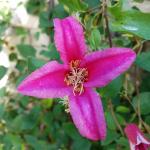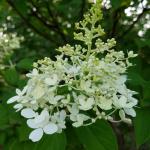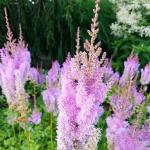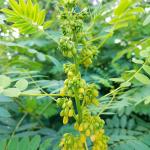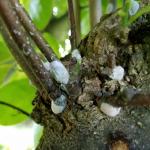UMass Extension's Landscape Message is an educational newsletter intended to inform and guide Massachusetts Green Industry professionals in the management of our collective landscape. Detailed reports from scouts and Extension specialists on growing conditions, pest activity, and cultural practices for the management of woody ornamentals, trees, and turf are regular features. The following issue has been updated to provide timely management information and the latest regional news and environmental data.
To read individual sections of the message, click on the section headings below to expand the content:
Scouting Information by Region
Environmental Data
The following data was collected on or about July 25, 2018. Total accumulated growing degree days (GDD) represent the heating units above a 50° F baseline temperature collected via our instruments for the 2018 calendar year. This information is intended for use as a guide for monitoring the developmental stages of pests in your location and planning management strategies accordingly.
|
MA Region/Location |
GDD |
Soil Temp |
Precipitation |
Time/Date of Readings |
||
|
2-Week Gain |
2018 Total |
Sun |
Shade |
|||
|
CAPE |
265 |
1248 |
78 |
71 |
0.20 |
11:00 AM 7/25 |
|
SOUTHEAST |
n/a |
1362.5 |
77 |
71 |
0.10 |
3:30 PM 7/25 |
|
NORTH SHORE |
285.5 |
1378 |
75 |
68 |
2.22 |
9:00 AM 7/25 |
|
EAST |
314.5 |
1539.5 |
77 |
72 |
2.91 |
5:00 PM 7/25 |
|
METRO |
326.5 |
1406 |
72 |
69 |
2.69 |
5:45 AM 7/25 |
|
CENTRAL |
260 |
1275 |
70 |
67 |
2.97 |
7:00 AM 7/25 |
|
PIONEER VALLEY |
323 |
1530 |
78 |
72 |
4.52 |
1:00 PM 7/25 |
|
BERKSHIRES |
218 |
1335 |
75 |
69 |
2.80 |
8:30 AM 7/25 |
|
AVERAGE |
285 |
1384 |
75 |
70 |
2.30 |
- |
|
n/a = information not available |
||||||
Drought conditions update: Viewing the map via the link below, dated July 26, shows Massachusetts is experiencing level D0 - 'Abnormally Dry' - in all areas of the following counties: Berkshire, Franklin, Hampden, Middlesex, Essex and Norfolk. The western halves of Franklin, Hampshire and Hampden Counties are categorized as D0. The northern halves of Bristol and Plymouth Counties are also 'Abnormally Dry'. There are no longer any areas suffering 'Moderate Drought'.
http://droughtmonitor.unl.edu/CurrentMap/StateDroughtMonitor.aspx?MA
Phenology
| Indicator Plants - Stages of Flowering (BEGIN, BEGIN/FULL, FULL, FULL/END, END) | ||||||||
|---|---|---|---|---|---|---|---|---|
| PLANT NAME (Botanic/Common) | CAPE | S.E. | N.S. | EAST | METRO W. | CENT. | P.V. | BERK. |
|
Hibiscus syriacus (Rose-of-Sharon) |
Begin |
Begin/Full |
Begin/Full |
Full |
Full |
Full |
Full |
Full |
|
Clethra alnifolia (Summersweet Clethra) |
Begin |
Begin |
Begin |
* |
Begin |
Begin |
Begin |
Begin |
|
Buddleia davidii (Butterfly Bush) |
Begin |
Begin/Full |
Full |
Full |
Full |
Full |
Begin/Full |
Begin/Full |
|
Hydrangea paniculata (Panicle Hydrangea) |
Begin/Full |
Begin/Full |
Begin/Full |
Full |
Full |
Begin |
Begin |
Begin |
|
Euonymus alatus (Winged Euonymus) |
* |
Begin |
* |
* |
* |
* |
* |
* |
|
Lythrum salicaria (Loosestrife) |
Begin/Full |
Begin/Full |
* |
Begin |
Begin |
Full |
Full |
Begin/Full |
|
Campsis radicans (Trumpet Vine) |
Begin/Full |
Begin/Full |
Full |
Full/End |
Full |
Full |
Full/End |
Full |
| * = no activity to report/information not available | ||||||||
Regional Notes
Cape Cod Region (Barnstable)
General Conditions: The average temperature over the last two weeks was 71° F with a high of 86° F on July 16 and a low of 52° F on July 21. Daytime highs have been in the high 70s and low 80s; nights have been primarily in the 60s with a few nights in the 50s and a of couple nights staying in the 70s. Humidity has been up and down with several days of high humidity followed by a couple of days of lower humidity. Approximately 0.2 inches of precipitation fell during the period. The last significant rainfall occurred on June 28, resulting in topsoil moisture conditions that are very short and subsoil moisture conditions that are short.
Pests/Problems: Insects or insect damage observed over the last week include Japanese beetle, Oriental beetle, Asiatic beetle, cottony camellia scale (Pulvinaria floccifera) on yew, Lecanium scale on oak, Hibiscus sawfly (Atomacera decepta) on hardy Hibiscus, turpentine beetle (Dendroctonus terebrans) on pitch pine, two spotted spider mite on annuals and herbaceous perennials, Andromeda lacebug (Stephanitis takeyai) on Japanese Andromeda, azalea lacebug (Stephanitis pyrioides) on 'PJM' Rhododendron, sycamore lacebug (Corythucha ciliate) on sycamore, and daylily leafminer (Ophiomyia kwansonis) damage on daylily. Diseases visible over the last week include leaf spot on Hydrangea, powdery mildew on the usual plants (Phlox, Monarda, lilac, peony), daylily leaf streak on daylily, black spot on rose, and cedar apple rust on crabapple. Plants such as flowering dogwood (Cornus florida) are showing symptoms of scorch in unirrigated landscapes. Weeds in bloom include: black swallowwort (Cynanchum nigrum), white clover (Tricolium repens), prostrate spurge (Euphorbia maculata), common groundsel (Senecio vulgaris), spotted knapweed (Centaurea maculosa), eastern black nightshade (Solanum ptycanthum), common sowthistle (Sonchus oleraceus), and tansy (Tanacetum vulgare). Rabbits are still abundant.
Southeast Region (Acushnet)
General Conditions: Lack of rain in our area has become a very important issue. Plants, shrubs, trees, etc are suffering for the lack of water. Lawns are dry and in a drought-induced dormant state. The rain on Sunday, July 22 was only about 0.09 inches. Irrigation must continue to irrigate to keep things hydrated through this period of hot and humid weather. The soil is very dry for many inches deep, showing once again what a dry state we are in. Slow, long periods of watering are necessary to hydrate the plants in our area. Well established plants should not be forgotten when watering. Much needed rain is welcome.
Pests/Problems: Many plants are suffering with fungus and powdery mildew from irrigation on foliage and humid weather. Blight, scale on hollies and sooty mold have been noted. Lily leaf beetles have been seen on Oriental lilies. Slugs are after Hostas and woodchucks are busy eating gardens. Birds are very actively eating blueberries and raspberries. Ticks have also been quite active and increasingly people are battling Lyme disease. Many pollinators have also been noticed out and about, such as hummingbird moths, bees, butterflies, dragonflies, hummingbirds and many others.
North Shore Region (Beverly)
General Conditions: This reporting period was hot and humid. Daytime temperatures were in the high 70s and low 80s. A temperature of 90° F was recorded on July 17. Night time temperatures were mostly in the low 60s to low 70s, with only a few nights in the high 50s. A few days experienced some fast moving storms which brought in much needed precipitation. Approximately 2.22 inches of rainfall were recorded at Long Hill during this reporting period. Woody plants seen in bloom include: golden rain tree (Koelreuteria paniculata), sourwood (Oxydendrum arboreum), silk tree or mimosa (Albizia julibrissin), bottlebrush buckeye (Aesculus parviflora), smoke bush (Cotinus coggygria), Indigofera (Indigofera amblyantha), oakleaf Hydrangea (Hydrangea quercifolia), false spirea (Sorbaria arborea), butterfly bush (Buddleia davidii), trumpet vine (Campsis radicans) and rose-of-Sharon (Hibiscus syriacus). Herbaceous plants seen in bloom include: shasta daisy (Leucanthemum x superbum), yarrow (Achillea millefolium), garden phlox (Phlox paniculata), Hostas (Hosta spp.), Sedums (Sedum spp.), Stachys (Stachys officinalis), meadow rue (Thalictrum rochebrunianum), Astilbe (Astilbe spp.), summer flowering roses (Rosa spp.), Clematis vines (Clematis paniculata), spiderwort (Tradescantia spp.), Persicaria (Persicaria polymorpha), water lily (Nymphaea odorata) and an assortment of annuals.
Pests/Problems: Possible Botrytis blight was observed on peony. Black spot (Diplocarpon rosae) was observed on roses, leaf necrosis probably caused by Phyllosticta leaf blotch was observed on witchhazel (Hamamelis intermedia) and leaf tip necrosis was observed on a Japanese stewartia, probably caused by anthracnose. If you notice these in your landscape, consider sending a sample to the UMass Extension Plant Diagnostic Lab for correct diagnosis of the problem. Poison ivy is growing vigorously in the landscape. Learn how to identify poison ivy to prevent exposure. Due to warm temperatures and moist soil, weeds are thriving. Take measures to control weeds before they set seed. Remember that mosquitoes and ticks are still very active. Protect yourself with insect repellent when working outdoors or walking in the woods.
East Region (Boston)
General Conditions: Typical summer weather has been consistent over the past two weeks. High temperatures ranged from 74° F to 90° F, averaging 82° F. Night time lows ranged from 56° F to 74° F, averaging 63° F. We received significant rain on July 17; over the course of the afternoon, 2.26 inches of rain fell, leaving soils moist and giving temporary relief from the high humidity. Of that total amount of rain, around an inch fell in a half hour span. Rain was quite localized on the 17th, as areas around the neighborhood received totals of over four inches of rain. The storm downed many smaller limbs and toppled an old oak tree. Many plants continue to bloom; hydrangeas of all shapes and sizes can be seen throughout the landscape. Perennial borders are especially colorful this time of year. Plants currently in bloom include: Asclepias tuberosa (butterflyweed), Echinacea purpurea (Eastern purple coneflower), Echinops ritro (the southern globe thistle), Hibiscus moscheutos (swamp rosemallow), Hosta spp. (Hosta), Hydrangea macrophylla (bigleaf Hydrangea), Hydrangea quercifolia (oakleaf Hydrangea), Liatris spicata (dense blazing star), Lilium canadense (Canada lily), Lysimachia clethroides (gooseneck loosestrife), Monarda didyma (scarlet beebalm), Oxydendrum arboretum (sourwood), Perovskia atriplicifolia (Russian sage), Phlox paniculata (garden phlox), Pontederia cordata (pickerelweed), Physostegia virginiana (obedient plant), Platycodon grandiflorus (balloon flower), Rhododendron prunifolium (plumleaf azalea), Rudbeckia hirta (black-eyed Susan), and Tanacetum vulgare (common tansy).
Pests/Problems: Despite significant rainfall on July 17, soil moisture continues to be a concern. Powdery mildew continues to be visible on lilac and many other plants. Adult Viburnum leaf beetles are feeding on susceptible Viburnum. Gypsy moth egg masses are becoming more numerous and can be easily spotted on lower branches and trunks of oaks. Crabgrass (Digitaria spp.) continues to grow; it is beginning to flower in the sidewalk cracks and on stonewalls. Weeds in flower include: Chenopodium album (pigweed), Cichorium intybus (chicory), Cyperus esculentus (yellow nutsedge), Daucus carota (Queen Anne's lace), Galinsoga quadriradiata (common quickweed), Phytolacca americana (pokeweed), Solanum dulcamara (bittersweet nightshade), and Solanum nigrum (European black nightshade). Seeds of tree of heaven (Ailanthus altissima) are maturing into a yellow or pink color and can be seen easily. Cicadas have been heard singing. Male cicada killers have emerged and have been fighting over territory. Despite this behavior, these large wasps do not sting.
Metro West (Acton)
General Conditions: If I had to use three adjectives to describe this July’s weather, I would use dry, muggy and hot. The historical monthly average rainfall for the month of July is 4.07” and as of the 24th, 3.46” of rain has been recorded so far this month, with 1 significant rain event on the 17th responsible for 2.04” of that total. Overall, there have been 10 days this summer with temperatures recorded in the 90s and 8 of those days occurred in July. In some stage of bloom at this time are the following woody plants: Aesculus parviflora (bottlebrush buckeye), Albizia julibrissin (silk tree), Buddleia spp. (butterfly bush), Clethra alnifolia (summersweet), Hibiscus syriacus (rose-of-Sharon), Hydrangea arborescens (smooth Hydrangea), H. paniculata (panicle Hydrangea), H. quercifolia (oakleaf Hydrangea), Oxydendron arboreum (sourwood), Potentilla fruiticosa (Potentilla), and Stewartia psuedocamellia (Japanese Stewartia). Woody vines in bloom are: Campsis radicans (trumpet vine) and Clematis spp. (Clematis). Contributing even more color and interest to the landscape are some flowering herbaceous plants including: Achillea millefoliumn (yarrow), Actaea matsumurae 'White Pearl' (bugbane), Alcea rosea (hollyhocks), Asclepias syriaca (common milkweed), A. tuberosa (butterfly weed), Astilbe spp. (false spirea), Campanula persicifolia (peach-leafed bell flower), C. takesimana ‘Elizabeth’ (bellflower), Cichorium intybus (chicory), Coreopsis spp. (tickseed), C. verticillata (threadleaf Coreopsis), Boltonia asteroides (Bolton’s aster), Daucus carota (Queen Anne's lace), Echinacea purpurea (coneflower), Gaillardia aristata (Indian blanket flower), Geranium sanguineum (cranesbill Geranium), Hemerocallis fulva (orange daylily), H. 'Stella D'Oro', (daylily), H. spp. (daylily), Hosta spp. (plantain lily), Hysopus oficinalis (hyssop), Lavendula angustifolia (lavender), Leucanthemum spp. (shasta daisy), Liatris spicata (spike gayfeather), Lilium spp. (lily), Lychnis coronaria (rose campion), Lysimachia clethroides (gooseneck loosestrife), Monarda didyma (bee-balm), Nepeta spp. (ornamental catmint), Oenothera macrocarpa (Ozark sundrops), Patrinia gibbosa (Patrinia), Perovskia atriplicifolia (Russian sage), Phlox carolina (Carolina Phlox), P. paniculata (garden Phlox), Platycodon grandiflorus (balloon flower), Rudbeckia fulgida var. Sullivantii 'Goldsturm' (black-eyed Susan), Solidago spp. (goldenrod), Thymus praecox (thyme), Tradescantia spp. (spiderwort), Verbena hastata (American blue vervain), Veronicastrum virginicum (Culver’s root), and Yucca filamentosa (Yucca).
Pests/Problems: Observed in the landscape these past two weeks were: leaf blotch on Aesculus spp. (horsechestnut), cedar apple rust on Amelanchier spp. (serviceberry) and powdery mildew on Cornus florida (dogwood), Monarda spp. (bee-balm), Phlox spp. and Syringa vulgaris (lilac). The lack of any substantial and steady rain continues to be a concern for our trees and shrubs in the landscape, especially compounded with the hot and humid weather and any other stresses such as winter cold spells, tent and/or gypsy moth caterpillars, hemlock woolly adelgid, snow and ice removal applications, or previous year’s droughts. On July 17th, the U.S. Drought Monitor declared a moderate drought for this area. Signs of stress are apparent in the landscape including premature leaf drop and wilt. Setting seed and quite visible is Ailanthus altissima (tree of heaven). Look for it growing along roadsides and in parking lots and medians.
Central Region (Boylston)
General Conditions: It has been a fairly warm and dry period with the exception of a few thunderstorms and downpours over the last 2 weeks, bringing just under 3” of rain most of which came down so quickly the majority didn't have a chance to soak in. In bloom for the last two weeks have been the following woody trees, shrubs and vines: Aesculus parviflora (bottlebrush buckeye), Clematis ‘Princess Diana’ (Clematis), Clethra alnifolia (summersweet), Hydrangea aspera (rough-leaf Hydrangea), Hydrangea paniculata (panicle Hydrangea) and Hydrangea quercifolia (oakleaf Hydrangea). Cultivar Hydrangea serrata ‘Bluebird’ (mountain Hydrangea) is beginning to bloom as is the heavily bud-laden Styphnolobium japonicum (Japanese pagoda tree), which has the most blooms seen in a number of years. Also in bloom in the last few weeks were the following herbaceous perennials: Achillea millefolium cultivars (blooming but beginning to wind down), Astilbe chinensis ‘Visions in Pink’ (Chinese Astilbe), Cassia marilandica (wild senna, heavily budded and beginning to bloom), Echinacea spp. and cvs (purple coneflower), Echinops ritro (globe thistle), Eupatorium purpureum (Joe-pye weed), Hemerocallis cvs. (daylilies), Hosta spp. and cvs. (plantain lily), Leucanthemum × superbum ‘Becky’ (shasta daisy), Liatris spicata (gayfeather), Phlox paniculata (garden phlox), Rudbeckia fulgida var. sullivantii ‘Goldsturm’ (brown-eyed Susan) and Vernonia noveboracensis (ironweed).
Pests/Problems: Neolecanium cornuparvum (Magnolia scale) females are very obvious on trees at this point. Only small numbers were observed and will either be pruned off or removed by hand. Japanese beetle and green June beetle are noticeable in the gardens. Weeds seen in bloom are: Lactuca serriola (prickly lettuce), Daucus carota (queen Anne’s lace) and Senecio vulgaris (groundsel). Celastrus orbiculatus (Oriental bittersweet) has fruits present on mature vines. Alliaria petiolata (garlic mustard) is blooming and will soon be removed.
Pioneer Valley Region (Amherst)
General Conditions: We’re deep in the dog days of summer as we approach the end of July in the Pioneer Valley. Since our last report it’s been both hot and muggy (7/15 through 7/17) and downright pleasant (7/20 and 7/21). The valley has experienced some major rain events as well over these past two weeks with widespread and scattered showers and thunderstorms on 7/17, 7/22–23 and at the time of writing on 7/25 (with more forecasted for 7/26). The repeated barrage of storms this week have tracked south to north, which isn’t typical for our region in the summer. This was due to a large low pressure system over the Great Lakes region that continuously pulled tropical moisture up from the south across the east coast. There’s been constant high humidity and persistent winds with the rain, with regular gusts near 30 mph recorded at Barnes airport in Westfield. The heavy rain is certainly welcome for landscape trees and shrubs still recovering from the 2016 drought or those besieged by the innumerable stresses of their urban or suburban existence. However, there have been flash flood warnings for streams and rivers in the valley, specifically the Green and Mill Rivers, and downed trees have knocked out power in some towns. The weather over the past week has been nearly ideal for most woody and non-woody plant pathogens due to regular rainfall, persistent winds, high humidity and high nighttime temperatures in the upper 60s to mid-70s. This type of weather makes it very easy for pathogens to sporulate in large quantities, disperse those spores and have them successfully germinate and invade tissues of susceptible hosts. Some landscape trees and shrubs continue to push new growth, indicative of good growing conditions. Kousa dogwood, eastern hemlock, crabapple and witchhazel are just a few of the several species observed over the past week with tender new growth.
Pests/Problems: The abundant rainfall this month has increased the incidence of various anthracnose diseases on landscape plants. The omnivorous Colletotrichum has been located on a wide array of plants, primarily deciduous hardwoods. Leaf scorch from the excessive heat the region experienced early this month is common at this time on a range of landscape trees and shrubs. Heat damage can occur on plants exposed to full sun, especially during the afternoon hours in settings where airflow is minimal. Additionally, if there are nearby surfaces that are absorbing and reflecting heat, like fencing, landscape stones and asphalt, this helps to amplify the heat. The damage can take place even when plants are well-watered but more often plants without irrigation suffer heat stress. Diffuse, interveinal browning in the center of the leaf is the most commonly observed symptom. Both sycamore and London planetree are shedding bark scales at this time. This is a normal process and isn’t cause for concern. However, while trees normally shed scales annually, for many trees the scales can build up from one year to the next, resulting a large volume of shedding that causes alarm. Continue to scout for and manage Dutch elm disease by locating flagging upper canopy branches and pruning them out. With the abundant rainfall, black spot of elm, a foliar anthracnose disease, is building up and symptoms can mimic those caused by DED.
Berkshire Region (Great Barrington)
General Conditions: Hot and steamy is probably the best way to describe the weather during the monitoring period from July 11 through July 25. Heat stress was a major concern for anyone working outdoors. Since it is expected that this will be the norm through this summer of record-breaking high temperatures, it pays to review not only the precautions to take but also the symptoms of heat stress and heat stroke. On the plus side, the dry conditions which characterized much of June and early July were abated by the rains of July 16-17 (1.80 inches measured at this Great Barrington site) and 0.71 inches on July 23. Rain continues to fall as this report is being prepared on July 25. Plants which had been showing symptoms of drought stress in previous weeks have mostly recovered. However, symptoms of heat scorch on foliage of some plants can be seen. Turfgrass which had been growing very slowly during the dry period has picked up its growth rate, although in non-irrigated lawns patches of dormant grass remain. Weed growth in lawns, gardens, and landscapes has been unfazed by the heat and growth has been rampant. Irrigated and/or mulched flower beds and borders display a vivid, colorful, and diverse show of blossoms.
Pests/Problems: The combination of heat, high humidity and now frequent rain has increased the number of plant diseases observed. Leaf spots and powdery mildew are most common. Sooty mold is a dark fungus which grows and reproduces in honeydew which is a sappy, sugary secretion from sucking type insects feeding on plant tissues. This honeydew drips on leaves, branches and everything beneath. Among the honeydew producing pests now observed in the landscape are magnolia and tulip tree scale on many species and cultivars of magnolia, aphids on tulip trees, and bowlegged aphids on Korean fir. Presence of sooty mold is a sure clue to the presence of these pests. Adult Japanese beetles are few at this point but some larvae (grubs) from eggs laid by the early emerged beetles are already being seen in the soil of turfgrass areas. Presence of the Japanese beetle grubs as well as soil inhabiting larvae of other insects has prompted skunks to dig up lawns in search of these tasty morsels. Most of this digging and feeding occurs at night, as anyone who has been awakened in the middle of the night by potent skunk odor can attest to. The population of chipmunks, voles and woodchucks seems to be quite high this year and the damage they cause, both via feeding on plant material and in tunneling, is a problem. Other insect pests recently observed or reported include: fall webworm on a wide variety of trees and shrubs, Asiatic garden beetle, willow leaf beetle (adults), four-lined plant bug, lace bugs and the mimosa webworm. Spruce spider mite and two-spotted spider mite are also common. Nuisance critters abound, including millipedes, centipedes and earwigs. With the recent abundance of rain, slugs and snails are plentiful and feeding on the foliage of many herbaceous ornamentals. Wasps, especially the paper nest building species, have become more than just a nuisance. Numerous people have told me of being stung by the wasps. The problem is that they build their nests in spots not very visible to human intruders, such as beneath the cover over an outdoor propane tank. Ground nesting wasps can also surprise someone working among trees and shrubs.
Regional Scouting Credits
- CAPE COD REGION - Russell Norton, Horticulture and Agriculture Educator with Cape Cod Cooperative Extension, reporting from Barnstable.
- SOUTHEAST REGION - Jacqueline Hoyle, Horticulturist, reporting from Acushnet.
- NORTH SHORE REGION - Geoffrey Njue, Green Industry Specialist, UMass Extension, reporting from the Long Hill Reservation, Beverly.
- EAST REGION - Kit Ganshaw & Sue Pfeiffer, Horticulturists, reporting from the Arnold Arboretum, Jamaica Plain.
- METRO WEST REGION - Julie Coop, Forester, Massachusetts Department of Conservation & Recreation, reporting from Acton.
- CENTRAL REGION - Dawn Davies, Interim Horticulture Manager, reporting from Tower Hill Botanic Garden, Boylston.
- PIONEER VALLEY REGION - Nick Brazee, Plant Pathologist, UMass Extension Plant Diagnostic Lab, reporting from UMass Amherst.
- BERKSHIRE REGION - Ron Kujawski, Horticultural Consultant, reporting from Great Barrington.
Woody Ornamentals
Diseases
Recent pests and pathogens of interest seen in the UMass Extension Plant Diagnostic Lab:
Needle blight and stem cankering of Korean pine (Pinus koraiensis) caused by Septorioides strobi, Sirococcus conigenus and Botryosphaeria. Tree is believed to be over 30 years old and has been present at the site for more than 20 years. The tree resides near the ocean on a ledge but is not exposed to direct winds and receives some supplemental water from lawn irrigation. Tree is browning in the upper canopy on only one side of the tree. Septorioides is widespread on eastern white pine in the region and can be located on a wide array of other soft and hard pines in landscape settings. Sirococcus causes a shoot and needle blight of pines, mostly in coastal settings in New England. Symptoms of the decline were not observed in previous years.
Infestation of the Norway spruce gall midge (Piceacecis abietiperda) and spruce spider mite (Oligonychus ununguis) on Norway spruce (Picea abies). A row of large trees at a residential property that are roughly 90-years-old. The upper canopies of some trees are appearing thin and the managing arborist suspected gall midges based on a positive ID from trees that appeared similarly on a different property. In many cases, the gall midge infestation kills the shoots. In this case, the shoots remained alive but had a significantly lower amount of needles compared to a normal, healthy shoot.
Needle blight of Ponderosa pine (Pinus ponderosa) caused by Dothistroma septorporum and Septorioides strobi. Tree is approximately 35-years-old and has been present at the site for 30 years. Older needles in the canopy are browning and prematurely shedding. The site includes full sun and sandy soils and no supplemental irrigation. Dothistroma is closely related to the brown needle spot pathogen (Lecanosticta) that is one of the leading causes of white pine needle blight. Dothistroma is far less common and prefers two- and three-needle pines.
Herbicide damage on weeping beech (Fagus sylvatica 'Pendula') and dogwood (Cornus sp.). The weeping beech is >12-years-old and resides in full sun with drip irrigation in a mulched bed with various other ornamentals adjacent to the house. The submitted foliage was highly irregular with deep lobes that resembled the foliage of Monstera or certain species of Philodendron. Additionally, the most recently produced leaves were normal in form, showing the plant was growing out of the injury. The dogwood is approximately 25-years-old and this spring, one half of the canopy exhibited undersized, deformed foliage. Specifically, the foliage exhibited a corkscrew pattern of growth, which can often indicate exposure to the broadleaf herbicide dicamba. When the managing arborist consulted with the homeowner, it was revealed that an herbicide was used along an adjacent walkway.
Ascochyta blight of lilac (Syringa vulgaris) caused by Ascochyta syringae. Lilacs at two different properties, one that is >50-years-old and resides in shade under nearby trees and does not receive supplemental water. Another is <10-years-old and resides in full sun with drip irrigation. Leaves and terminal shoots were found browning and curling. Submitted foliage had marginal blotching and brown, interveinal blotches. The fungus produces very small, black-colored fruiting bodies that disperse spores during wet and mild weather. Typically, Ascochyta blight is not overly destructive on lilacs in the landscape.
Report by Nick Brazee, Plant Pathologist, UMass Extension Plant Diagnostic Lab, UMass Amherst.
Insects
Recent insect-related submissions to the UMass Plant Diagnostic Laboratory:
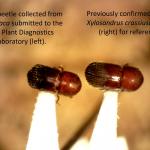
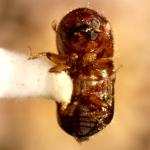
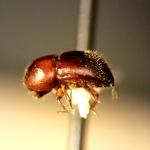 Granulate ambrosia beetle: (Xylosandrus crassiusculus) A sample of Ilex opaca (American holly) was submitted to the UMass Plant Diagnostics Laboratory after collection on 7/6/2018. The host plant was one of multiple 7 ft. plants purchased from an out-of-state nursery. Adult, immature insects, and eggs were present in the sample material submitted.
Granulate ambrosia beetle: (Xylosandrus crassiusculus) A sample of Ilex opaca (American holly) was submitted to the UMass Plant Diagnostics Laboratory after collection on 7/6/2018. The host plant was one of multiple 7 ft. plants purchased from an out-of-state nursery. Adult, immature insects, and eggs were present in the sample material submitted.
- Status: Non-native, invasive ambrosia beetle from tropical and subtropical Asia; has been widely introduced elsewhere, including into the United States.
- Occurrence in USA: Alabama, Arkansas, Connecticut, Delaware, Florida, Georgia, Illinois, Indiana, Kansas, Kentucky, Louisiana, Maryland, Massachusetts (detected in traps in Bristol County in 2010), Michigan, Mississippi, Missouri, Nebraska, New Jersey, New York, North Carolina, Ohio, Oklahoma, Oregon, Pennsylvania, Rhode Island, South Carolina, Tennessee, Texas, Virginia, and West Virginia.
- Host Plants: Many, including but not limited to: aspen, beech, cherry, Chinese elm, crape myrtle, dogwood, golden rain tree, hickory, holly, Japanese snowbell, locust, Magnolia, maples, mimosa, oaks, peach, persimmon, redbud, sweet gum, tulip poplar, and walnut.
- Damaged Caused: includes visible symptoms such as wilted foliage, and "toothpick-like" wood shavings extending outside of entrance holes which are tiny and round. Branch die back and eventual death of the host plant is possible. The granulate ambrosia beetle tends to be a bit more aggressive than other closely related Xylosandrus spp. beetles, according to reports.
- Life Cycle: These tiny ambrosia beetles (females are 2.1-2.9 mm long and males are 1.5 mm long) bore into twigs, branches, or small trunks of susceptible woody plants. The females excavate a system of tunnels in the wood or pith and into these tunnels they introduce a symbiotic ambrosial fungus. Within the tunnels, the females produce young (a brood). Their young feed on the introduced fungi, not the wood or pith of the host. So the wood shavings produced by these insects are from tunneling activities and are not frass (excrement) produced through feeding. Eggs, larvae, and pupae are all found within the tunnels created by the females. This species does not make individual egg niches, larval tunnels, or pupal chambers. This species most commonly utilizes small diameter branches and stems. Males are rare.
- Hawthorn leafminer: (Profenusa canadensis) A sample of Crataegus spp. (hawthorn) was submitted to the UMass Plant Diagnostic Laboratory after collection on 7/10/2018. These are established trees in a landscape.
- Status: Native insect with at least two known wasp parasites (Aptesis segnis and Trichogramma minutum) which are often capable of managing populations.
- Occurrence in USA: Found in the Northeast, west to Iowa, Missouri, and Arkansas.
- Host Plants: This insect is commonly found on Crataegus crus-galli, C. persimillis, and C. erecta. C. mollis may be less commonly mined. This wasp-like sawfly was also first described as a pest of sour cherries, Prunus cerasus.
- Damaged Caused: Freshly hatched larvae begin to feed in the space between leaf surfaces. This feeding creates mines that eventually coalesce into blotches. These blotches become brown in color and may take up most of the leaf. By mid-June, the larvae drop from the leaves and much black colored, pellet-like frass (excrement) is left behind within the mines.
- Life Cycle: The sawfly is found in the pupal stage in the ground at the start of the growing season. When host plant leaves begin to unfold and blossom buds begin to open, the adult sawflies emerge. Female sawflies will lay their eggs singly in the upper epidermis at the base of the leaf. Freshly hatched larvae begin to feed in the space between leaf surfaces. Several larvae can be found in a single leaf. The larvae will mine together, eventually causing large blotches to form which can cover 1/2 the leaf. The larvae are flattened in shape and grow up to 7 mm. in length when fully grown. By mid-June, the larvae leave the foliage and drop to the ground to make cells in the soil within which to overwinter. From a distance, heavily infested trees look like they have been singed by fire due to the brownish cast of the leaves. Injury to the tree is not permanent, especially in years when new leaves develop rapidly.
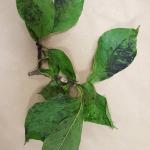
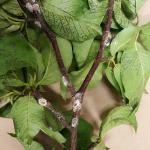 Magnolia and Tuliptree scales: The soft scale insects included in the sample material submitted (Magnolia spp.) are either the Magnolia scale (Neolecanium cornuparvum) or the tuliptree scale (Toumeyella liriodendri). The sample, from an established tree in the landscape, was collected on 7/17/18 and sent to the UMass Plant Diagnostics Laboratory.
Magnolia and Tuliptree scales: The soft scale insects included in the sample material submitted (Magnolia spp.) are either the Magnolia scale (Neolecanium cornuparvum) or the tuliptree scale (Toumeyella liriodendri). The sample, from an established tree in the landscape, was collected on 7/17/18 and sent to the UMass Plant Diagnostics Laboratory.
- Status: As two native scale insects in North America, the Magnolia and tuliptree scales are hosts themselves for natural enemies that can impact their populations. Solitary parasitoid larvae have been collected from Magnolia scales and have been identified as a syrphid fly species, Ocyptamus costatus. The natural enemies of the tuliptree scale have been studied to a greater degree and include certain lady beetle species [Hyperaspis signata, Adalia (formerly Hyperaspis) bipunctata, and Chilocorus stigma] which feed on nymphal scales, a number of parasitic wasps, and even an insect feeding moth caterpillar (Laetilia coccidivora). This particular moth species, also referred to as a type of snout moth, will consume the tuliptree scale underneath the protection of a silken web it spins over them! (The specific epithet coccidivora can be translated as “ones that eat soft scales” or Coccidae.) Unfortunately, in a landscape setting, it often seems that although these natural enemies may be common within the scale populations, they are seldom able to reduce the scale insect numbers below damaging levels. That being said, our management options should still seek to preserve these natural enemies.
- Occurrence in USA: The Magnolia scale is distributed throughout the eastern United States. The tuliptree scale is found east of the Mississippi River from Michigan to Alabama and from New York and Connecticut to Florida. It is also reported to be found in ornamental tuliptrees and Magnolias in California and could be found wherever these trees are grown.
- Host Plants: Magnolia scale host plants include: Magnolia stellata (star Magnolia), M. acuminata (cucumber Magnolia), M. lilliflora ‘Nigra’ (lily Magnolia; formerly M. quinquepeta), and M. soulangeana (Chinese Magnolia). Other species may be hosts for this scale, but attacked to a lesser degree. M. grandiflora (southern Magnolia) may be such an example. Tuliptree scale host plants include: Liriodendron tulipifera (tuliptree or yellow poplar), Magnolia stellata (star Magnolia), and M. soulangeana (Chinese Magnolia). This insect has also been recorded on M. grandiflora (southern Magnolia) and Tilia spp. (linden). The tuliptree scale has also, to a lesser extent, been reported on other ornamental trees and shrubs. *On Magnolia, it is very difficult to distinguish between the two species of soft scale.
- Damaged Caused: Mature individuals settle on a location on branches and twigs, then insert piercing-sucking mouthparts to feed. The insects feed on plant fluids and excrete large amounts of a sugary substance known as honeydew. Sooty mold, often black in color, will then grow on the honeydew that has coated branches and leaves. Repeated, heavy infestations can result in branch dieback and at times, death of the plant. Honeydew may also be very attractive to ants, wasps, and hornets.
- Life Cycle: The life cycle of both of these species is similar and may have similar timing during the year, however subtle differences exist. The life cycle of the Magnolia scale is as follows: This scale overwinters as a young nymph (immature stage) which is elliptical in shape, mostly a dark-slate gray, except for a median ridge that is red/brown in color. These overwintering nymphs may be found on the undersides of 1st and 2nd year old twigs. The first molt (shedding of the exoskeleton to allow growth) can occur by late April or May in parts of this insect’s range and the second molt will occur in early June. At that time, the immature scales have turned a deep purple color. Stems of the host plant may appear purple in color and thickened – but this is a coating of nymphal Magnolia scales, not the stem itself. Eventually, these immature scales secrete a white layer of wax over their bodies, looking as if they have been rolled in powdered sugar. By August, the adult female scale is fully developed, elliptical and convex in shape and ranging from a pinkish-orange to a dark brown color. Adult females may also be covered in a white, waxy coating. By that time, the females produce nymphs (living young; eggs are not “laid”) that wander the host before settling on the newest twigs to overwinter. In the Northeastern United States, this scale insect has a single generation per year.
The lifecycle of the tuliptree scale is as follows: The mature female tuliptree scale is hemispherical in shape. The color of the mature female varies in this species as well - a grayish-green to pink-orange insect mottled with black. Adult males emerge sometime in June and mate with the females. Like the Magnolia scale, eggs develop within the body of the female tuliptree scale, leading to the “live birth” of immatures (crawlers) in late August and September. In the Northeast, one generation of tuliptree scales occurs per year. (However, in the southern-most portions of its range, this insect has been found in all stages of development during the winter, suggesting multiple generations per year.) A single female tuliptree scale may produce 3,000+ crawlers in one season. These crawlers are tiny (approximately the size of the head of a pin) and settle on host plant twigs in September. Past studies have shown that in addition to moving on their own with fully functional legs, the crawlers can be blown to new hosts on the wind, up to 100 feet away. (Being wind-blown to a new host, however, is a haphazard method of travel through which some less than 20% of these crawlers successfully make contact with a host plant, and fewer still attach to a suitable site on the plant.) The immature, crawler stage molts once prior to overwintering.
Woody ornamental insect and non-insect arthropod pests to consider, a selected few:
- Asian Longhorned Beetle: (Anoplophora glabripennis, ALB) Look for signs of an ALB infestation which include perfectly round exit holes (about the size of a dime), shallow oval or round scars in the bark where a female has chewed an egg site, or sawdust-like frass (excrement) on the ground nearby host trees or caught in between branches. Be advised that other, native insects may create perfectly round exit holes or sawdust-like frass, which can be confused with signs of ALB activity. Adult insects may be seen beginning in July in the regulated area in Massachusetts. The regulated area for Asian longhorned beetle is 110 miles2 encompassing Worcester, Shrewsbury, Boylston, West Boylston, and parts of Holden and Auburn. If you believe you have seen damage caused by this insect, such as exit holes or egg sites, on susceptible host trees like maple, or believe you have captured or taken a photo of an adult insect, please call the Asian Longhorned Beetle Eradication Program office in Worcester, MA at 508-852-8090 or toll free at 1-866-702-9938.
To report an Asian longhorned beetle find online or compare it to common insect look-alikes, visit: http://massnrc.org/pests/albreport.aspx or https://www.aphis.usda.gov/pests-diseases/alb/report .
- Asiatic Garden Beetle: Maladera castanea adults are active and are typically most abundant in July and August. These rusty-red colored beetles are bullet-shaped and active at night. They are often attracted to porch lights. They feed on a number of ornamental plants, defoliating leaves by giving the edges a ragged appearance and also feeding on blossoms. Butterfly bush, rose, dahlia, aster, and chrysanthemum can be favored hosts. When levels of damage reach a management threshold, pyrethroid- based insecticides may be necessary. Read and follow label instructions and avoid harming non-target organisms. Certain neem oil products are also labelled for use against adult beetles. Observe label instructions to minimize the potential for leaf injury.
- Deer Tick/Blacklegged Tick: Ixodes scapularis adult females, following a blood meal, can lay a single egg mass (up to 1500 – 2000 eggs) in mid-late May, then the female deer tick perishes. Larvae emerge from the eggs later in the summer. Larvae are tiny and six-legged. Prior to feeding, they are not known to be able to transmit disease. After feeding, the larvae drop from their host and molt, re-emerging the following spring as nymphs. Nymphs (from last year’s overwintering cohort) are active from May-August. Nymphs are eight-legged and about the size of the head of a pin. These tiny nymphs typically attach to small mammal hosts; however, they will readily feed on people and pets. Nymphs are capable of carrying Lyme disease, human Babesiosis, human Anaplasmosis, and deer tick virus. For images of all deer tick life stages, along with an outline of the diseases they carry, visit: http://www.tickencounter.org/tick_identification/deer_tick .
Anyone working in the yard and garden should be aware that there is the potential to encounter deer ticks. Preventative activities, such as daily tick checks, wearing appropriate clothing, and permethrin treatments for clothing (according to label instructions) can aid in reducing the risk that a tick will become attached to your body. If a tick cannot attach and feed, it will not transmit disease. For more information about personal protective measures, visit: http://www.tickencounter.org/prevention/protect_yourself .
Have you just removed an attached tick from yourself or a loved one with a pair of tweezers? If so, consider sending the tick to the UMass Laboratory of Medical Zoology to be tested for disease causing pathogens. To submit a tick to be tested, visit: https://www.tickreport.com/ and click on the red “Test A Tick” button. Results are typically available within 3 business days, or less. By the time you make an appointment with your physician following the tick attachment, you may have the results back from TickReport to bring to your physician to aid in a conversation about risk.
The UMass Laboratory of Medical Zoology does not give medical advice, nor are the results of their tests diagnostic of human disease. Transmission of a pathogen from the tick to you is dependent upon how long the tick had been feeding, and each pathogen has its own transmission time. TickReport is an excellent measure of exposure risk for the tick (or ticks) that you send in to be tested. Feel free to print out and share your TickReport with your healthcare provider.
You can also follow TickReport on Twitter @TickReport for timely updates from the Laboratory of Medical Zoology, including the latest tick and tick-borne disease related research.
- Emerald Ash Borer: (Agrilus planipennis, EAB) New community and county detections have been made in Massachusetts since the last Landscape Message was published. New community detections were made in Hampden and Berkshire Counties and EAB was detected for the first time in Bristol County, MA. All new detections were confirmed by the MA Department of Conservation and Recreation. This wood-boring beetle readily attacks ash (Fraxinus spp.) including white, green, and black ash and has also been found developing in white fringe tree (Chionanthus virginicus) and most recently, has been reported in cultivated olive (Olea europaea). Signs of an EAB infested tree may include D-shaped exit holes in the bark (from adult emergence), “blonding” or lighter coloration of the ash bark from woodpecker feeding (chipping away of the bark as they search for larvae beneath), and serpentine galleries visible through splits in the bark from larval feeding beneath. Positive identification of an EAB-infested tree may not be possible with these signs individually on their own.
For further information about this insect, please visit: https://ag.umass.edu/fact-sheets/emerald-ash-borer . If you believe you have located EAB-infested ash trees, particularly in an area of Massachusetts not identified on the map provided, please report here: http://massnrc.org/pests/pestreports.htm .
- Fall Webworm: Hyphantria cunea is native to North America and Mexico. It is now considered a world-wide pest, as it has spread throughout much of Europe and Asia. (For example, it was introduced accidentally into Hungary from North America in the 1940’s.) Hosts include nearly all shade, fruit, and ornamental trees except conifers. In the USA, at least 88 species of trees are hosts for these insects, while in Europe at least 230 species are impacted. In the past history of this pest, it was once thought that the fall webworm was a two-species complex. It is now thought that H. cunea has two color morphs – one black headed and one red headed. These two color forms differ not only in the coloration of the caterpillars and the adults, but also in their behaviors. Caterpillars may go through at least 11 molts, each stage occurring within a silken web they produce over the host. When alarmed, all caterpillars in the group will move in unison in jerking motions that may be a mechanism for self-defense. Depending upon the location and climate, 1-4 generations of fall webworm can occur per year. Fall webworm adult moths lay eggs on the underside of the leaves of host plants in the spring. These eggs hatch in late June or July depending on climate. Fall webworm caterpillars were reported for 2018 previously in the Pioneer Valley Region report and expanding webs were seen the week of 7/4/18 in Chesterfield, MA. Young larvae feed together in groups on the undersides of leaves, first skeletonizing the leaf and then enveloping other leaves and eventually entire branches within their webs. Webs are typically found on the terminal ends of branches. All caterpillar activity occurs within this tent, which becomes filled with leaf fragments, cast skins, and frass. Fully grown larvae then wander from the webs and pupate in protected areas such as the leaf litter where they will remain for the winter. Adult fall webworm moths emerge the following spring/early summer to start the cycle over again. 50+ species of parasites and 36+ species of predators are known to attack fall webworm in North America. Fall webworms typically do not cause extensive damage to their hosts. Nests may be an aesthetic issue for some. If in reach, small fall webworm webs may be pruned out of trees and shrubs and destroyed. Do not set fire to H. cunea webs when they are still attached to the host plant.
- Lace Bugs: Corythucha spp. and Stephanitis spp. lace bugs are active. Corythucha spp. utilize many hosts such as hawthorn, cotoneaster, Amelanchier, quince, Pyracantha, various oaks, birch, maple, mountain ash, sycamore, hackberry, elm, walnut, butternut, basswood, etc. Corythucha spp. adult lace bugs were seen feeding on bur oak on 6/13/2018 in Amherst, MA. Many adult lace bugs were seen on leaf undersides, along with groups of tiny, black eggs. These groups of lace bug eggs were seen on nearly every leaf examined within reach on this tree. Egg are so small, they may look like fungal spores without magnification. Corythucha spp. adult and nymphal lace bugs were seen feeding on sycamore on 7/9/18 in Amherst, MA. The species that is most commonly found on sycamore is Corythucha ciliata, or the sycamore lace bug. This insect is found throughout the United States and parts of Canada. This lace bug, like most, can be found feeding on leaf undersides, initially causing a white stippling that can sometimes progress to chlorotic or bronzed foliage and may (when severe) lead to premature leaf drop.
Stephanitis spp. lace bugs are active. Yellow stippling on leaf surfaces, black colored tar-like spots on leaf undersides, and lace bug nymphs (immatures) were seen on leaf undersides on 5/30/18, 6/7/18, and 6/13/18 in Amherst, MA on Rhododendron spp. foliage. Stephanitis spp. lacebugs such as S. pyriodes can cause severe injury to azalea foliage. S. rhododendri can be common on Rhododendron and mountain laurel. S. takeyai has been found developing on Japanese Andromeda, Leucothoe, Styrax, and willow. Stephanitis spp. lace bug activity should be monitored through September. Before populations become too large, treat with a summer rate horticultural oil spray as needed. Be sure to target the undersides of the foliage in order to get proper coverage of the insects. Fall or early spring soil treatment with imidacloprid has been effective, but be aware of the implications this may have on pollinators attracted to these flowering plants when making management decisions. Certain azalea and Andromeda cultivars may be less preferred by lace bugs.
- Tuliptree Aphid: Illinoia liriodendri is a species of aphid associated with the tuliptree wherever it is grown. (They may at times also feed on magnolia, according to reports.) The tuliptree aphid was seen feeding on the undersides of leaves on 7/9/18 in Amherst, MA. Depending upon local temperatures, these aphids may be present from mid-June through early fall. Large populations can develop by late summer. Some leaves, especially those in the outer canopy, may brown and drop from infested trees prematurely. The most significant impact these aphids can have is typically the resulting honeydew, or sugary excrement, which may be present in excessive amounts and coat leaves and branches, leading to sooty mold growth. This honeydew may also make a mess of anything beneath the tree. Wingless adults are approximately 1/8 inch in length, oval, and can range in color from pale green to yellow. There are several generations per year. This is a native insect. If management is deemed necessary, select options that will preserve natural enemies, as ladybeetles and other beneficial insects are often associated with the tuliptree aphid.
- Two-Spotted Spider Mite: Tetranychus urticae is a “warm-season” mite that loves hot and dry weather, which may favor the quick reproduction and build-up of this pest. Management should seek to preserve beneficial predatory mites. Monitor susceptible hosts (elm, maple, redbud, ash, black locust, tuliptree, and many deciduous shrubs) for increasing numbers of these mites until mid-August. Mites will be found on the undersides of leaves and cause stippling of the foliage.
- Viburnum Leaf Beetle: Pyrrhalta viburni is a beetle in the family Chrysomelidae that is native to Europe, but was found in Massachusetts in 2004. Viburnum leaf beetle egg hatch was observed in Boston, MA on 5/4/2018. By early to mid-June, Viburnum leaf beetle larvae will crawl down the host plant, enter the soil surface, and pupate. This typically occurs when the larvae are just under ½ inch in length. After pupation, by early-July, adult beetleswill emerge from the soil and begin feeding on Viburnum foliageagain prior to mating and laying eggs. This beetle feeds exclusively on many different species of Viburnum, which includes, but is not limited to, susceptible plants such as V. dentatum, V. nudum, V. opulus, V. propinquum, and V. rafinesquianum. Larvae, where they are present, may be treated with a product containing spinosad. Some Viburnum have been observed to have varying levels of resistance to this insect, including but not limited to V. bodnantense, V. carlesii, V. davidii, V. plicatum, V. rhytidophyllum, V. setigerum, and V. sieboldii. More information about Viburnum leaf beetle may be found at http://www.hort.cornell.edu/vlb/ .
- White Spotted Pine Sawyer (WSPS): Monochamus scutellatus adults can emerge in late May throughout July, depending on local temperatures. The first report of a white spotted pine sawyer adult came from the Asian Longhorned Beetle Eradication Program in Worcester, MA. A concerned citizen in Hampshire County, MA reported (with a photo) a white spotted pine sawyer adult on 5/22/2018. A second report of 3 white spotted pine sawyers came to UMass Extension from a concerned citizen in Hampden County, MA on 6/8/2018. The report was given with photos that clearly allowed for the insect to be identified. This report was shared with the ALB Eradication Program. This is a native insect in Massachusetts and is usually not a pest. Larvae develop in weakened or recently dead conifers, particularly eastern white pine (Pinus strobus). However, the adult white spotted pine sawyer looks very similar to the invasive Asian Longhorned Beetle, Anoplophora glabripennis, ALB. ALB adults do not typically emerge in Massachusetts until July and August. Now is the time to look for the key difference between WSPS and ALB adults, which is a white spot in the top center of the wing covers (the scutellum) on the back of the beetle. White spotted pine sawyer will have this white spot, whereas Asian longhorned beetle will not. Both insects can have other white spots on the rest of their wing covers; however, the difference in the color of the scutellum is a key characteristic. See the Asian longhorned beetle entry above for more information about that non-native insect. (And where to go to report anything suspicious.)
Concerned that you may have found an invasive insect or suspicious damage caused by one? Need to report a pest sighting? If so, please visit the Massachusetts Introduced Pests Outreach Project: http://massnrc.org/pests/pestreports.htm .
A note about Tick Awareness: deer ticks (Ixodes scapularis), the American dog tick (Dermacentor variabilis), and the lone star tick (Amblyomma americanum) are all found throughout Massachusetts. Each can carry their own complement of diseases. Anyone working in tick habitats (wood-line areas, forested areas, and landscaped areas with ground cover) should check themselves regularly for ticks while practicing preventative measures. Have a tick and need it tested? Visit the web page of the UMass Laboratory of Medical Zoology (https://www.tickreport.com/ ) and click on the red Test a Tick button for more information.
Reported by Tawny Simisky, Extension Entomologist, UMass Extension Landscape, Nursery, & Urban Forestry Program
Plant of the Week
Here is another important native plant, currently blooming, for your consideration when landscaping: https://extension.umass.edu/plant-identification/joe-pye-weed
Bridgit Litchfield reporting for Mandy Bayer
Additional Resources
To receive immediate notification when the next Landscape Message update is posted, be sure to join our e-mail list and follow us on Facebook and Twitter.
For a complete listing of upcoming events, see our Upcoming Educational Events page.
For commercial growers of greenhouse crops and flowers - Check out UMass Extension's Greenhouse Update website
For professional turf managers - Check out Turf Management Updates
For home gardeners and garden retailers - Check out home lawn and garden resources. UMass Extension also has a Twitter feed that provides timely, daily gardening tips, sunrise and sunset times to home gardeners, see https://twitter.com/UMassGardenClip
Diagnostic Services
A UMass Laboratory Diagnoses Landscape and Turf Problems - The UMass Extension Plant Diagnostic Lab is available to serve commercial landscape contractors, turf managers, arborists, nurseries and other green industry professionals. It provides woody plant and turf disease analysis, woody plant and turf insect identification, turfgrass identification, weed identification, and offers a report of pest management strategies that are research based, economically sound and environmentally appropriate for the situation. Accurate diagnosis for a turf or landscape problem can often eliminate or reduce the need for pesticide use. For sampling procedures, detailed submission instructions and a list of fees, see Plant Diagnostics Laboratory
Soil and Plant Nutrient Testing - The University of Massachusetts Soil and Plant Nutrient Testing Laboratory is located on the campus of The University of Massachusetts at Amherst. Testing services are available to all. The function of the Soil and Plant Nutrient Testing Laboratory is to provide test results and recommendations that lead to the wise and economical use of soils and soil amendments. For complete information, visit the UMass Soil and Plant Nutrient Testing Laboratory web site. Alternatively, call the lab at (413) 545-2311.
Ticks are active at this time! Remember to take appropriate precautions when working and playing outdoors, and conduct daily tick checks. UMass tests ticks for the presence of Lyme disease and other disease pathogens. Learn more
